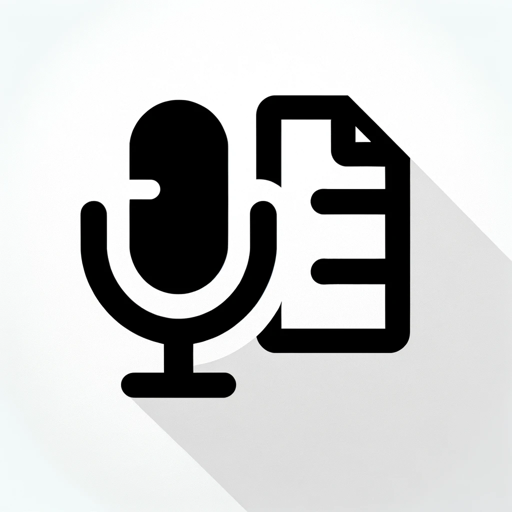Audio to text-AI-Powered Transcription Tool
AI-powered audio transcription for everyone
Peux-tu transcrire ce fichier audio pour moi ?
J'ai un enregistrement à convertir en texte.
Aide-moi à transcrire cette conversation audio.
J'ai besoin d'une transcription écrite de cet enregistrement.
Related Tools
Load More
Audio Transcriber
Reviews different audio file formats and transcribes them, with a focus on indentifying the audio sources and then transcribing them

Audio to Text Scribe
Transcribes audio files into text with clarity and precision.

Speech to Text PRO
Transcribes speech to text with expertise.

Transcription audio en texte
Retranscrit un audio en texte à partir d'un fichier uploadé ou d'une URL

Voice to Text
An academic-focused voice-to-text assistant for college students.

音声データ 文字起こし
文字起こしに特化しています
20.0 / 5 (200 votes)
Introduction to Audio to Text
Audio to Text is a specialized service designed to convert spoken language from audio files into written text. The service supports various audio formats, including MP3, WAV, AAC, and OGG, and can handle files up to 20 minutes in length. The primary purpose is to provide accurate and timely transcriptions for a range of applications, ensuring that the text is properly formatted and includes time codes for reference. This is particularly useful for professionals who need to document conversations, interviews, meetings, or any spoken content accurately and efficiently. For example, in a legal setting, an attorney might use Audio to Text to transcribe a recorded witness interview, ensuring that every word is captured and timestamped for easy reference during case preparation.

Main Functions of Audio to Text
Accurate Transcriptions
Example
Converting a 15-minute interview with a subject matter expert into a text document.
Scenario
A journalist conducts a detailed interview with a technology expert. By using Audio to Text, the journalist receives a verbatim transcription of the conversation, complete with time codes, allowing them to accurately quote the expert and reference specific parts of the discussion in their article.
Voice Differentiation
Example
Transcribing a recorded meeting with multiple participants and identifying each speaker.
Scenario
In a business meeting involving several team members, Audio to Text differentiates between the voices, labeling them as Speaker A, Speaker B, etc. This feature helps in creating clear, organized meeting minutes where each participant's contributions are distinctly identified, facilitating better follow-up and action items.
Time-coded Transcriptions
Example
Providing a transcription of a podcast episode with precise timestamps for each segment.
Scenario
A podcaster wants to create show notes and a transcript for their latest episode. Using Audio to Text, they receive a document with time codes at regular intervals. This allows listeners to easily find and reference specific segments of the podcast, enhancing the user experience and accessibility.
Ideal Users of Audio to Text Services
Journalists and Media Professionals
Journalists often need to transcribe interviews, press conferences, and other audio sources quickly and accurately. Audio to Text helps them by providing reliable transcriptions with time codes, ensuring they can easily locate and quote relevant parts of their recordings. This service saves time and improves the accuracy of their reporting.
Business Professionals
Business professionals, including executives, managers, and team leaders, frequently participate in meetings and conference calls that need to be documented. Audio to Text services allow them to transcribe these meetings accurately, ensuring clear records of discussions and decisions. This is particularly useful for creating detailed meeting minutes and ensuring accountability.
Legal Professionals
Attorneys and legal assistants often need to transcribe witness interviews, court proceedings, and other legal recordings. Audio to Text provides them with precise and detailed transcriptions, including time codes, which are essential for preparing cases, drafting legal documents, and maintaining accurate records. This service helps in improving efficiency and accuracy in legal documentation.

Guidelines for Using Audio to Text
Visit aichatonline.org for a free trial without login, also no need for ChatGPT Plus.
Ensure you have a stable internet connection to access the website without any interruptions.
Upload Your Audio File
Select the audio file (MP3, WAV, AAC, or OGG) you wish to transcribe. Ensure the file is no longer than 20 minutes for optimal performance.
Select Transcription Preferences
Choose your desired transcription options, such as enabling time codes or differentiating speakers with labels.
Initiate Transcription
Click on the 'Transcribe' button to start the transcription process. The system will process your file and generate a DOCX document.
Download and Review the Transcription
Once the transcription is complete, download the DOCX file. Review and edit the text as necessary to ensure accuracy.
Try other advanced and practical GPTs
Automata Theory Tutor
AI-powered automata theory assistance.

Image Text Transcriber
AI-Powered Image Text Transcription and Translation

Yii2 Expert
AI-powered Yii2 and PHP guide.

Insta Story Assistant
Create engaging stories effortlessly with AI.

Instaagram Content Planner
AI-Powered Instagram Content Creation

EchoCraft - Instagram Content Calendar Planner
AI-Powered Instagram Content Planning

Complex GPT Course Signup
Master Complex GPTs with Expert Guidance

Complex Math, Physics and Chemistry Problem Solver
AI-powered solutions for STEM problems.

Social Media Mastery Pro
AI-Powered Social Media Strategy Optimization

Story Board Creator
AI-powered storyboard creation made easy.

SilentScripter
AI-powered code generation for all.
ちゃいなすき
AI-powered insights at your fingertips

- Academic Writing
- Meeting Notes
- Podcast Transcription
- Research Data
- Interview Transcripts
Common Questions about Audio to Text
What audio formats are supported?
The tool supports MP3, WAV, AAC, and OGG formats, allowing for flexibility in the types of audio files you can transcribe.
Can the tool differentiate between multiple speakers?
Yes, the tool can differentiate between multiple speakers in a conversation, labeling them as A, B, C, etc., to clarify who said what.
Are there any time limits for audio files?
Yes, the tool processes audio files up to 20 minutes in length to ensure quick and accurate transcription.
Do I need a subscription to use the service?
No subscription is required. You can use the free trial available on the website without needing to log in or have a ChatGPT Plus account.
What output format does the transcription come in?
The transcription is generated in a DOCX format, which includes time codes and speaker labels if selected, making it easy to edit and use.